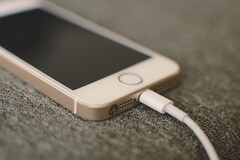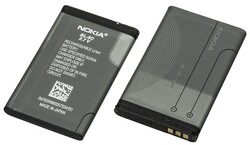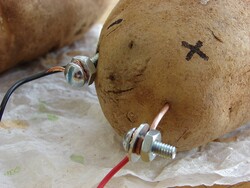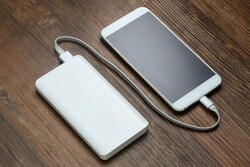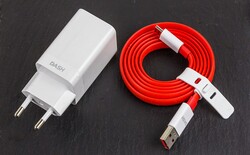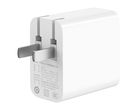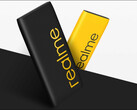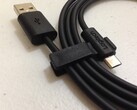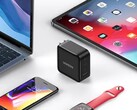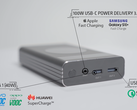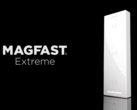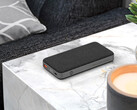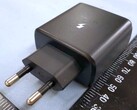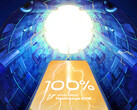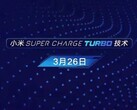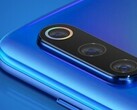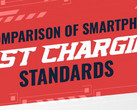The basics of battery charging
Batteries themselves consist of three main parts: the anode, the cathode, and the electrolyte between them. Anodes and cathodes are essentially just the connectors that give the circuitry access to the electricity stored inside the cell. The electrolyte consists of a solution that, when an electrical charge is present, has an excess of electrons with a negative charge. Those charged particles stack up at the anode, desperate to offload their which starts to happen when the circuit is completed.
Charging systems also consist of three main components. First is the converter, which is commonly (but actually erroneously) called the charger. Its primary responsibility is to turn AC current into DC current, and each one has a predetermined maximum rate. Second is the charging circuit, which is in charge of drawing current supplied by the converter and directing it - generally at a dynamic rate - into the battery, which is the third main component. The charging circuit is what determines the type of fast charging used by a device as it communicates with the battery using software that's programmed into the device. Manufacturers decide which standards to implement in their charging circuits, and that's where the various different converter capacities come into play. If a device isn't programmed to accept anything other than the standard USB 2.0 rate, which is 5 volts at 500 milliamperes, that's all it can draw, period. Thanks to Ohm's law, we know that this equals 2.5 watts, and that can take a relatively long time to charge a modern smartphone fully.
That said, it's not a linear progression from empty to 100%. Power management circuits are designed to fill a battery quickly at first and then enter one or more slower cycles that work progressively more slowly as the battery fills up, which is why the last 15-20% tends to take just as long as the first 75% did. Ultimately, it's between zero and roughly 80% where fast charging technologies are most active.
What's bad for a battery, and what's no big deal
For years, there have been quite a few myths floating around about various settings and actions that can harm a battery's lifespan, or worse, cause dangerous overheating or even explosions. Thankfully - aside from the Galaxy Note 7 fiasco - we've seen next to zero danger of smartphones spontaneously exploding, but there are certain behaviors that can have detrimental effects, although they do take a long time to actually manifest.
First off, here's what's not true. It's not possible to "overcharge" a phone; once it's at 100%, the circuit stops the charging process and won't provide any more power to the device than is necessary for its standard operation. Second, in 2020, there's no pressing need to disable location services such as GPS or local Bluetooth scanning, as those protocols have been optimized to significantly reduce their power drain.
Furthermore, it doesn't really help and can possibly waste electricity to constantly close background apps when you're not using them, especially if you're likely to open those apps again in the near future. The fact is that takes more electricity for your phone to close and then reopen apps than it does for them to remain in the background occupying a minimal amount of RAM. Finally, it's not hugely important - as far as actual battery health is concerned - to use converters and cables made by your phone's manufacturers, although it can affect fast charging speeds in some cases. Some protocols work slightly better with an OEM-branded cable, while some won't fast charge and will revert to traditional wattages, but there's no actual risk when mixing reputable brands of chargers, cables, and phones.
So what difference does it make whether or not you even pay attention to long-term battery health? Most obviously is the fact that battery capacity degrades over time simply due to the nature of the physics involved. You may well remember the relatively massive outcry when iOS was found to slow devices as the battery life decreased. Apple appears to have backed off that stance after offering discounted battery replacements for affected devices. For most, if not all electronics on the market today, though, the biggest drawback of careless battery management is an increasingly lower capacity.
As far as actual risks to battery lifespan go, heat is one of the main agitators. Excess heat is the bane of almost all electronics, and batteries are no exception. Keeping a phone under your pillow at night as it charges, for example, is one behavior that is definitely a terrible idea (yes, people do this). Additionally, lithium ion cells have only a finite number of charging cycles. This number is, admittedly, quite high, and average users shouldn't have to worry a whole lot about using them up in the course of the one to three years they own their smartphone. If, however, you typically use your mobile device for high-drain activities such as a mobile hot spot or video streaming device, it's worth considering plugging it in while you're using it so as to offload the power drain to a wall outlet or more easily replaceable battery pack.
Possibly the most harmful to long-term battery life, though - and totally separate from fast charging rates - is extreme cycling. The chemistry of Li-ion cells means that they're most stable at between 50% and 70% charge, generally speaking, and the farther you get from that range, the more likely you are to be hurting your overall capacity. Of course, we're not saying that dipping below 30% or even running the battery out every now and then will actually cause noticeable damage - these behaviors only cause problems if they become habits. If you do find yourself regularly operating at or below 20% charge, it's entirely possible you will notice a degraded battery after a year of use.
Similarly, if you always keep devices topped off at 100%, you run the risk of that 100% number not meaning quite what it did 18 months ago. If you're the type of electronics junkie who upgrades their phone every year to be in line with the newest releases, then more power to you, because you might just not care. Because not everyone is so inclined, however, it's an important concept to keep in the back of your mind. Naturally, don't hesitate to top it off all the way when necessary, because why would you pay for such a capable phone if you can't use it when you need it? On the other hand, being aware of real-world battery issues is a good way to maximize your investment and keep a phone in peak condition for as long as you want to use it.
The right fast charging standards for your mobile device
With all the general information out of the way, it's time to delve into which hardware you'll need for the fastest refueling experience. It's important to mention, once again, that there are plenty of variables in place, and also that some are cross-compatible while some are not. To further complicate things, even when standards work decently well with one another, you may still find better charging performance when pairing an official OEM converter (charger) with your high-end device. When there is such a difference, though, it may be negligible, and the most important thing to remember is to avoid ultra-cheap off-brand chargers, because no matter what their marketing materials tell you, safety is of the utmost concern. In that respect, reputable manufacturers are always the first place to look.
USB Power Delivery
Determined by none other than the venerable USB Implementers Forum, USB Power Delivery, or USB PD, is capable of a 100W peak, which is tied for first place among all protocols. It's especially useful for high-end Ultrabooks, 2-in-1s, and even many more traitional laptops. If you're using a device that boasts PD compatibility, there are a few things that you can be certain of thanks to the powerful standardization demands of the USB-IF.
The protocol allows for interchangeable two-way power through a single port, so you can use a hub to charge your laptop while that same hub also power additional devices (provided there's headroom left over, of course) or you can power those peripherals using a laptop or tablet's Type-C port, turning a laptop into a de facto multi-port charger when using the common DC barrel plug input. Another lifespan-saving feature is flexible power draw, which means that compatible devices can communicate with the USB controller to appropriate the specific wattage they need for quick and safe charging.
The original USB PD standard offers this high capacity and flexible compatibility, and naturally, versions 2.0 and 3.0 are both backward-compatible with the first iteration. The advancements among the two newest versions include not only more intelligent charging rates for supported devices (which means faster adaptive charging rates), but also significantly more metadata that laptops and tablets can use to communicate with everything they're powering and being powered by. As long as your device supports the upgraded standard, PD 2.0 and 3.0 will charge it faster than the original Power Delivery protocol would.
It's also worth remembering that you'll need cables that are specifically certified for use with these standards in order to make the most of them. In fact, in the early days of Power Delivery, it wasn't unheard of for slightly incompatible devices to get actually damaged or even totally fried by using the wrong cable. Thankfully, this problem has been all but eliminated over recent years, and as long as you're careful when selecting a cable and charger vendor, a good USB-IF certified USB PD setup should take good care of your laptop or tablet's battery for quite a long while.
So, where is Power Delivery an especially important consideration? Aside from removing the need to carry a standalone power brick just for an Ultrabook, it's the primary fast charging standard used by many modern smartphones including new iPhones and Google Pixel phones as well as a number of mobiles driven by the Snapdragon SoC. If you regularly use devices from a variety of manufacturers, USB PD is the most likely to work well with all of them, even if some products would see a slight increase in charging rates with a different type of charger.
Qualcomm Quick Charge
Because Qualcomm's responsible for the Snapdragon chipset line, which generates more revenue than any other SoC on the market, Qualcomm QC is one of the most widespread standards. From the original specification through versions 1.0 and 2.0, this common protocol offers 10W, 18W, and 36W maximums, and moves up to a full 100W for Quick Charge 4 and 4+. While an overwhelming majority of Snapdragon smartphones have the hardware capability to utilize at least one form of the standard, it is still up to device manufacturers to enable the feature. As mentioned above, some producers are loathe to include the high-wattage versions, although Samsung has finally caved and included QC 2.0 in their latest flagship phones.
Aside from just a high maximum output, there are several interesting features that manufacturers can implement using QC. One of them is Dual Charge technology, which involves having a second charging circuit alongside the first, which shares the load and significantly reduces heat dissipation, allowing for faster recharging with less long-term damage from increased temperatures. Another is dynamic voltage adjustment, starting with 200mV steps in version 3.0 and moving to 20mV increments in 4 and beyond. This technology is known as INOV, which stands for Intelligent negotiation for Optimum Voltage.
In a rare case of various companies adopting the same or similar high-quality protocol, any of these third-party systems should work quite well with an advanced enough Qualcomm Quick Charge converter. Due to the huge prevalence of Qualcomm QC chargers, many consumers will be more than satisfied if they fall back on its cross-compatibility.
Other, less popular standards
The popularity of Quick Charge means that various other manufacturers have piggybacked with it to provide a speedier experience with their handsets. Compatible standards include Motorola TurboPower, Asus BoostMaster, Samsung Adaptive Charge, and Vivo Dual-Engine Fast Charging, also known as Mediatek PumpExpress. One caveat is that you may have better results if you stick with your phone's high-end OEM charger (just not the one that comes with the phone, as that's usually a base-level model), but that's not the certainly not case for every device and the difference may actually be negligible in real-world use.
Then there's Oppo's VOOC technology. It stands for Voltage Open Loop Multi-step Contant-Current Charging (and it's a good thing they shortened that) and its version 2.0 starts at 5V/4A resulting in 20 watts of charging. Version 3.0 is increased to 5A of current, while the newest iteration, SuperVOOC features a maximum output of 10V and 6.5A, which makes for a whopping 65W of charging power in best conditions.
Normal fast charging doesn't inherently harm batteries, but modulating current instead of voltage may increase heat dissipation that can, in fact, have detrimental effects. Some experts claim that even the 40W version of SuperVOOC degrades battery capacity to 70% in the same span during which 15W charging would have reduced capacity to just 90%. If it was a standard charging circuit, that would definitely be likely. However, we should point out that Oppo has made an effort to both increase performance and minimize damage by using a bi-cell battery design that lets it essentially use two batteries as one and charge them separately, too. As such, the jury is still out, so to speak, on the long-term consequences of SuperVOOC charging, but it's entirely possible that it doesn't have any meaningful negative effects.
On the other hand, because VOOC utilizes dynamic current rather than voltage, there's little to no cross-compatibility in terms of fast charging standards, hardware, and cables. If you want to use this high-performing method, you'll need to make certain that every link in your chain supports it. A minor exception to that are OnePlus phones, which use a licensed version of VOOC to provide Dash and Warp charging, and while they aren't marketed as such, they are generally compatible with Oppo's proprietary protocol.
Anker PowerIQ
This an interesting one because, like USB Power Delivery and Qualcomm Quick charge, it's designed to work across various manufacturers' hardware, although it's not quite as well known or as widespread as PD and it's a little bit tougher to navigate than QC; it works perfectly with many popular smartphones, decently with others, and very poorly with some. Generally speaking, PowerIQ 2.0 is noticeably slower than Quick Charge 3.0, although it can and does beat standard 500mA charging rates.
PowerIQ 3.0 certainly appears to do a great job of joining all the competing standards, and coupled with the generally agreeable prices and reliability of the brand's products, it's a worthwhile choice for many users. It claims to be as fast as QC 3.0 and to charge high-end Samsung Galaxies and iPhones to 50% in about 30 minutes. Outside of those two families, your mileage may vary (for example, some Motorola owners report that it charges their phones at standard rates only), but it's definitely worth a look if you want a single charger that can accommodate various devices, and if you don't necessarily need the absolute fastest speeds on the planet.
Huawei also has its own proprietary standard called Super Fast Charging, which tops out at 40W. Like Oppo's method, it uses dynamic current adjustment that could theoretically cause long-term heat issues, although the evidence has yet to determine if that's true. Honestly, one of its biggest drawbacks, Huawei's recent forced departure from the Google Play Services ecosystem, also applies to all their handsets. It remains to be seen if the coming months lead to the Chinese smartphone giant's reentry into the US market, but we're not holding breath. Unfortunately, a smartphone without access to the Google Play Store is just not terribly useful outside of China. On the other hand, if you have an older Huawei model that Google still supports, its proprietary charging method performs on a par with the very fastest.
Conclusions
Selecting a fast charging protocol and speed involves deciding on a tradeoff between charging times and long-term battery health. However, if you use a traditional 500mAh converter or PC USB-A port whenever you're not in a rush, you're on the right track to keeping your battery healthy and efficient. Keeping charge levels between roughly 50% and 80% through daily use is also a great idea, but it's most important to avoid dipping below 20% while minimizing the amount of time you spend over 90%. It's especially important to use cables rated for fast charging and, ideally, the specific protocol you're using. This is particularly important if you're using a high-current standard such as SuperVOOC or Huawei Super Fast Charge. Furthermore, keeping your device away from heat sources (especially while plugged in) may seem like a no-brainer, but it's worth keeping in mind.
We should also point out that if you put your Android device into Stamina mode, its fast charging capabilities may be extremely limited. This one goes both ways: if you want to get the most out of your fast charger, make sure to disable Stamina mode while charging, and if you want to slow the rate nearer to a trickle to ensure low heat and the best possible long-term battery health, don't be afraid to keep Stamina mode on when your device is plugged in.
USB Power Delivery and Qualcomm Quick Charge are far and away the most common and useful standards, though Anker PowerIQ is proving to be ever more useful as it now mimics many of QC 3.0's specifications. All three of these work by adjusting voltage levels, so they should all work with the same cables. The majority of users will be satisfied by one of these three protocols, but you'll still want to double check before you settle on one. We always love to hear from you, so let us know in the comments which standards you've had success with, or been unsatisfied by, and which devices you have experience with.




